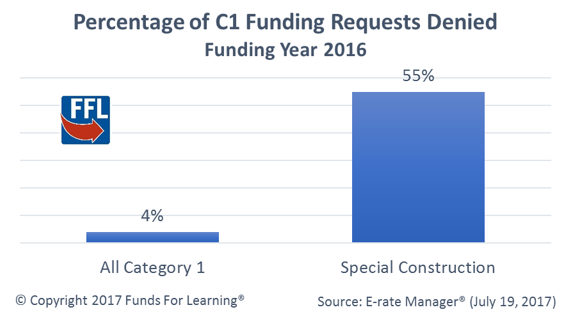Y’all ever wonder exactly what makes Special Construction…special? I mean, we’re already imbued with so much specialness in our daily lives! To wit:
Special sauce!
Special agents!
Special!
But come on. Special sauce is really just 1000 Island dressing. Cars can’t really bend like that. And (all respects to Shirley Manson) was Garbage ever really anyone’s favorite band?
And then in the E-rate world, we have SPECIAL construction. How exciting does that sound? “I’m going to get a specially constructed network just for me!” But increasingly, the reality is that special construction leads to special questions, special delays, and special headaches.
Thanks to the FCC’s increased transparency requirements in the Seventh Report and Order, we can now track every E-rate funding application where discounts have been requested for Special Construction. As of July 19, the data shows 426 FRNs for Special Construction in Funding Year 2016. 397 have received a funding decision thus far, and of those, 55% have been denied.
Does that seem a bit high to you? It does to me. Overall in Category One for FY2016, only 3.8% of FRNs with a funding decision have been denied.

So what’s going on? The funding decision explanations give us some highlights:
- 25 FRNs were denied due to RFP addendums not being “available for service providers to review for 28 days” after they were posted to the EPC portal.
- 13 FRNs were denied for charges which were determined to be beyond a USAC-internal cost-effectiveness threshold1.
- 38 FRNs reference services on the Form 471 which are “substantially different” than the services referenced on the Form 470 (most appear to be line item category/description mismatches.)
- 97 FRNs (about 25% of the total Special Construction FRNs, both funded and not funded) were modified to correct “average cost per foot of outside plant” figures.
- Four FRNs were “canceled to correct a data entry error by the Program Administrator.”
- A whopping 109 FRNs (a quarter of total Special Construction requests) were cancelled by the applicant.
And the data is replete with interesting one-off denial reasons, including familial relationships between applicant and service providers, applicants “specifying a preference” of self-provisioning (which “deter[s] other service providers from submitting a bid”), lack of valid contracts, applicants not considering all submitted bids, applicants specifying equipment makes/models without “or equivalent” in the text of their bids, invalid bid evaluation criteria, and more.
Sounds like it’s time to consult a specialist2. What advice do we have for applicants seeking support for special construction in FY2018 and forward? Make a plan, get started early, keep meticulous records, and, if I may be so bold, do whatever you do to conjure up a bit of luck.
It is very clear from reading through denial and modification explanations for Special Construction FRNs that they are all flagged for special scrutiny. Case in point – the overwhelming majority of denials (that aren’t due to cancellation) are for general E-rate compliance issues that aren’t unique to fiber or Special Construction at all. Here’s a few tips:
- Prepare for a Selective Review. You may not get one – or at least not so-named – but it’s obvious that these FRNs are being reviewed in exactly the same level of detail applied when a Selective Review is conducted. For more information about Selective Reviews, visit https://www.usac.org/e-rate/applicant-process/application-review/selective-review/.
- Watch your RFPs and addendums carefully. There are a surprising number of denials due to non-compliance with the 28 day bidding requirement after RFP addendums were issued. Presumably, USAC found “cardinal” information in the addendums that they felt required an extension of the bid period3. Regardless of whether you agree with their position or not, the only way you can guarantee compliance is holding your bid open for an additional 28 days past any RFP addendums that are issued.
- Give yourself time to refile everything. In FY2016, USAC guidance was changing and evolving during the period of time when many applicants had open bids on the street. Some were even an initial “green light” by USAC only to have conflicting guidance issued later. We hope that clearer and more consistent information is on its way, but in the meantime best practices dictate that applicants carefully monitor all USAC News Briefs and other information, and build flexibility into their procurement timelines to account for a complete rebid if necessary.
It bears mentioning that discounts have been approved for around $90M worth of Special Construction charges, so applicants who are willing to put in the work can, in fact, see the reward. There were even 20 FRNs which were funded without any apparent modifications. To those applicants, we offer a tip of our hat:
1 These are pretty easy to search for, because USAC’s boilerplate decision explanation references figures “outside of the excepted range of construction costs.” We assume they mean “expected.” We also have no clue what that range might be.
2 See what I did there? I’ve been talking about all this special stuff, then I used the term “specialist.” It works two ways, because I am one of those specialists, so it serves as both a Grade B+ pun as well as a thinly veiled advertisement for our services. Behold my genius. Our marketing folks are going to love this. I’ll show myself out.
3 I highly suspect that many of these addendums were at USAC’s suggestion due to their outreach efforts during applicants’ bid processes. We don’t have data on how many applicants were contacted or what suggestions were made, however, so this is just an educated guess.
